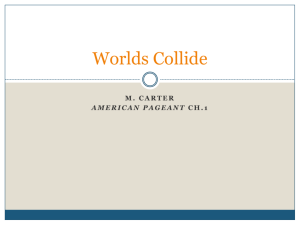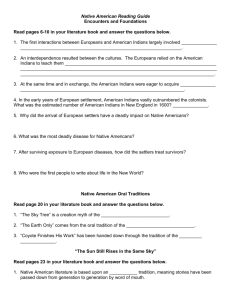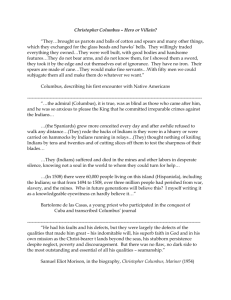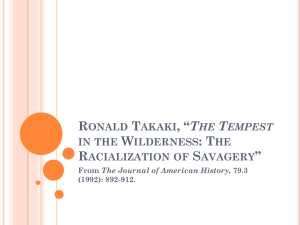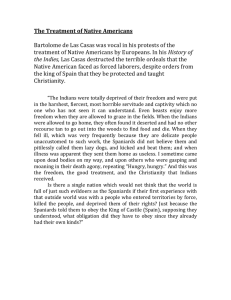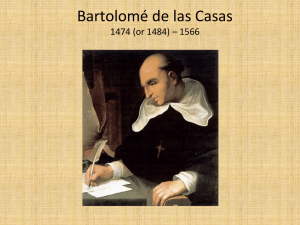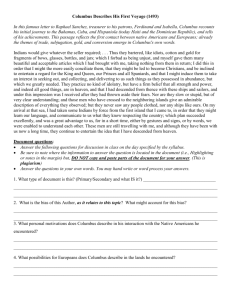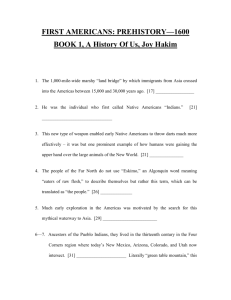chapter 1 powerpoint
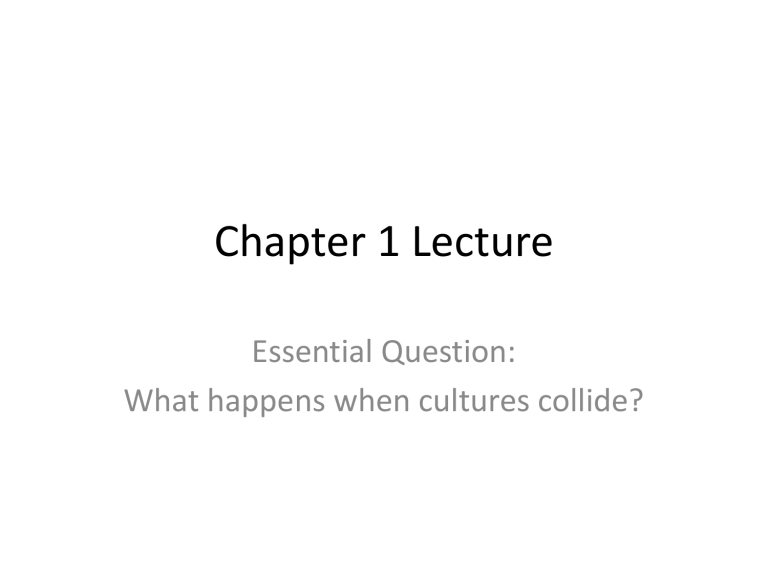
Chapter 1 Lecture
Essential Question:
What happens when cultures collide?
The Big Idea
• Everything you learn in class will be organized under an essential question – the big idea. As you read chapter 1 and watch this PowerPoint, consider the essential question from the first slide.
• Our conversations the first week back from school will center on the essential question.
Two General Views of Indians
• Many Europeans viewed Native Americans as either noble “savages” that were innocent, kind, and respectful of the environment.
• Another group of Europeans viewed Native
Americans as dishonest, manipulative, and totally willing to drastically alter the physical landscape.
– Which view makes more sense to you?
Dude, Indians are innocent and noble.
These two guys were the ones who came up with the different views of
Native Americans.
Your mom.
De Las Casas
Sepulveda
Two Franciscan monks in Spain, De Las Casas and Sepulveda, migrated to South America.
They had a bro-mance until their views of Native Americans made them into “frenemies.”
De Las Casas
The Black Legend
De Las Casas’ view was popular in England because he said the Spanish killed, tortured, and stole in the Americas, while contributing nothing good. This became known as the
Black Legend.
Of course, England would believe anything that made Spain look bad, since Spain and
England did not like each other.
So, who is more correct, De Las Casas or Sepulveda?
Who was more correct, De Las Casas or Sepulveda?
• The answer is probably a bit of both.
– Let’s take a look at the Indian peoples of North and South America before Columbus arrived (that is, before 1492).
– Let’s also take a look at the initial impact of Indian and European interactions after 1492.
The Americas…
The Indian peoples of the Americas were divided into many diverse cultures speaking more than two thousand different languages.
Native Americans in North and South
America had complex societies with alliances and enemies, just like the
Europeans.
The Americas…
One example is the Iroquois
Confederacy.
Five Indian nations created a military alliance and promised to help each other in order to defeat their enemies.
The Confederacy remained strong until the American Revolution in 1776!
The Americas…
Aztec Empire
Mayan Empire
Another example were the Aztec,
Mayan, and Incan Empires waged large-scale wars, created alliances, and greatly altered the environment.
The Americas…
• Some Native Americans, like the Arawak of the
Caribbean, were very kind and generous.
• They had few enemies and seemed to respect each other and the environment.
Meanwhile in Europe…
The Christian Crusaders brought back to Europe a taste for the silks and spices of Asia.
You studied the
Crusades way back in
World History class – remember?
Who was that cute guy I sat next to?
Meanwhile in Europe…
Unite all the kingdoms under one king and queen. Wad ya say y’all?
Spain kicks out
Muslim invaders and unifies itself as a country.
Queen
Isabela
Spain is unified under one queen. This allows them to concentrate their efforts on exploration instead of political infighting.
Spain becomes the most powerful country in Europe because the rest of Europe is still fighting with one another.
Meanwhile in Europe…
Spices and silks from Asia were transported by ship around Africa back to Europe– way lame.
Christopher Columbus thinks there’s a shorter route to all those riches in Asia; he sails West from the newly unified country of Spain.
The Collision of Cultures Begins
Columbus thinks he’s in India
(hence the term “Indians”).
He expects to find gold, jewels, silk, and spices.
The Norse got to
North America before
Columbus, but they don’t get the credit.
Where’s the love bro?
The Collision of Cultures Begins
• Instead of the riches from Asia, Columbus discovers about 20 million “Indians” in North
America.
• Instead of bringing back tons of gold, he brings back a few Indians, as well as maize
(corn), beans, and tomatoes. Europe (the Old
World) s the vegetables.
Many Indians loved squash but it’s not popular in Europe
The Collision of Cultures Begins
• But Spain doesn’t want veggies, they want gold and Columbus needs to pay back the money he borrowed for his voyages.
• Columbus decides to take Indian slaves back to Spain to sell. Most of the Indians die on the way to Europe.
• So, Columbus and some other Spaniards decide to copy what the Portuguese had done.
The Collision of Cultures Begins
• The first ocean explorers were Portuguese
(remember Ferdinand Magellan?).
The Portuguese were the first
Europeans to enter the slave trade and establish large-scale plantations using slave labor.
Columbus totally copies the Portuguese.
The natives of these Islands were enslaved by the
Portuguese
Portugal was an early colonial competitor to Spain.
The Collision of Cultures Begins
• Encomiendas!!
– The large-scale plantations that used Indians as slave labor in the Caribbean and South America were called encomiendas.
– Encomiendas were supposed to convert the Indians to
Christianity.
– In return for saving their souls from Hell the Indians were supposed to work for the Spaniards.
The encomiendas grew the veggies and spices Europe demanded.
Encomiendas also supplied the food and resting areas for Conquistadors going to South America.
The Collision of Cultures Begins
• Many Spaniards treated the Native Americans terribly on the enconmienda.
Umm… yea.. about that…
De Las Casas sees this and eventually flips out. He wrote a book about what he saw.
The Collision of Cultures Begins
Hernan Cortes
The Conquistadors set sail from the Caribbean encomiendas and began to conquer Central and South
America.
Francisco Pizarro
The Collision of Cultures Begins
Hernan Cortez conquered the Aztecs because the Aztec ruler
Montezuma believed the Conquistadors were gods. What an epic fail.
“La Malinche” was born to a small , fearful tribe between the mighty Aztec and Mayan empires. She spoke many languages and served Cortes (even had a baby with Cortes!) in his conquest of the
Aztecs. Pay-backs are a b**ch!
The Collision of Cultures Begins
Much worse than European conquest, colonization, and encomiendas to the
Indians were their lack of resistance to diseases like malaria and smallpox.
The initial number of Native Americans in the Americas is debatable, so it’s difficult to determine exactly how many Native
Americans were killed by European contact, but as much as 90% of some
Native populations died from disease.
The Collision of Cultures Begins
Sepulveda v. De Las Casas
• Which view is more accurate of Native
Americans? Why?
• What ideas do the two debaters share?
• How much truth is there to the Black Legend?
• What were the consequences of two cultures colliding?
